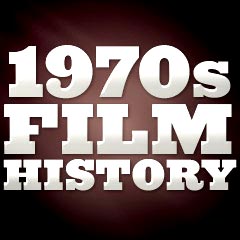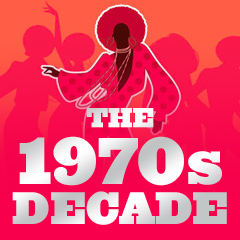|
Mel Brooks:
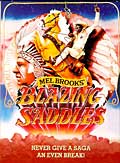 In
some cases, comedy reached new lows of vulgarity and tasteless jokes in
this decade. After his breakthrough film in the previous decade, The
Producers (1968), about Nazis and Broadway musicals, Mel Brooks further
used comic stars Gene Wilder, Marty Feldman, Madeline Kahn and Cloris
Leachman in two films in 1974. Brooks' first in a series of satirizing
parodies of classic movie genres (often as star, scripter and director)
was his lewd and raunchy western comedy Blazing
Saddles (1974) - his first commercial hit. It told the story of
the Waco Kid (Gene Wilder) and Black Bart (Cleavon Little) - a black sheriff
recruited to clean up a white frontier town. It was most remembered for
its famous campfire scene with gaseous cowboys. In
some cases, comedy reached new lows of vulgarity and tasteless jokes in
this decade. After his breakthrough film in the previous decade, The
Producers (1968), about Nazis and Broadway musicals, Mel Brooks further
used comic stars Gene Wilder, Marty Feldman, Madeline Kahn and Cloris
Leachman in two films in 1974. Brooks' first in a series of satirizing
parodies of classic movie genres (often as star, scripter and director)
was his lewd and raunchy western comedy Blazing
Saddles (1974) - his first commercial hit. It told the story of
the Waco Kid (Gene Wilder) and Black Bart (Cleavon Little) - a black sheriff
recruited to clean up a white frontier town. It was most remembered for
its famous campfire scene with gaseous cowboys.
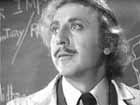 Next,
Brooks spoofed Universal's mad-scientist, Frankenstein cycle
of horror films with Young Frankenstein (1974) -
one of his best films, with Gene Wilder as the infamous brain surgeon,
Peter Boyle as the Monster, Marty Feldman as hunchbacked Igor, and
Teri Garr as the voluptuous lab assistant. Brooks' follow-up parody
was the self-indulgent Silent
Movie (1976), a
tribute to the early slapstick days of Hollywood with Mel Funn (Mel
Brooks) as a washed up film producer who tried to recruit celebrities
in Hollywood for his film, including Burt Reynolds, Paul Newman, Anne
Bancroft, and others. It was noted for only one spoken word delivered
by mime Marcel Marceau. And the shallow and obvious High
Anxiety (1977) spoofed
scenes and themes from various Alfred Hitchcock films, notably Psycho's
(1960) shower scene. Brooks' influence on comedy films
extended from Airplane! (1980), a lampoon of disaster
flicks, to the randy teenage sex comedy American Pie (1999) and
beyond. Next,
Brooks spoofed Universal's mad-scientist, Frankenstein cycle
of horror films with Young Frankenstein (1974) -
one of his best films, with Gene Wilder as the infamous brain surgeon,
Peter Boyle as the Monster, Marty Feldman as hunchbacked Igor, and
Teri Garr as the voluptuous lab assistant. Brooks' follow-up parody
was the self-indulgent Silent
Movie (1976), a
tribute to the early slapstick days of Hollywood with Mel Funn (Mel
Brooks) as a washed up film producer who tried to recruit celebrities
in Hollywood for his film, including Burt Reynolds, Paul Newman, Anne
Bancroft, and others. It was noted for only one spoken word delivered
by mime Marcel Marceau. And the shallow and obvious High
Anxiety (1977) spoofed
scenes and themes from various Alfred Hitchcock films, notably Psycho's
(1960) shower scene. Brooks' influence on comedy films
extended from Airplane! (1980), a lampoon of disaster
flicks, to the randy teenage sex comedy American Pie (1999) and
beyond.
Absurdist Monty Python Films:
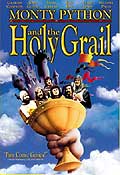 The
decade was also assaulted with the irreverent, absurdist, off-beat British
film comedies from BBC-TV's early 70s Monty Python's Flying Circus mad-cap
gang including: The
decade was also assaulted with the irreverent, absurdist, off-beat British
film comedies from BBC-TV's early 70s Monty Python's Flying Circus mad-cap
gang including:
- And Now for Something Completely Different (1971),
a series of TV vignettes and comedy sketches
- Monty Python and the Holy Grail (1975) (their
first feature film) - a spoof of Arthurian legends, with Knights who
Say 'Ni' and a carnivorous rabbit
- the satirical (and sacrilegious to some viewers) Monty
Python's Life of Brian (1979), with a reluctant Messiah in ancient
Palestine named Brian Cohen (Graham Chapman) and his misled disciples,
and noted for the line of dialogue: "Blessed are the cheese-makers"
- Monty Python's The Meaning of Life (1983)
Other Comedies:
Playwright Neil Simon wrote the original screenplay for Murder By
Death (1976) as a lightweight spoof of fictional film detectives and
sleuths such as Miss Marple, Nick and Nora Charles, Sam Spade, Hercule
Poirot and Charlie Chan. Director Robert Mulligan's Same Time, Next
Year (1978) was an adult-themed romantic comedy about a long-running
marital affair (once annually) between Alan Alda and Ellen Burstyn. And
another comedy House Calls (1978) told of a hospital romance between
widowed doctor Walter Matthau and recent-divorcee Glenda Jackson.
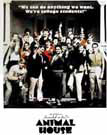 Outrageousness
prevailed in the Delta fraternity house (at Faber College) in director
John Landis' gross-out comedy National Lampoon's Animal House (1978),
with Saturday Night Live TV comedian John Belushi in his film debut
as Bluto Blutarsky (memorable for instigating a gross food fight and for
the comic line: "Was it over when the Germans bombed Pearl Harbor?").
Other TV stars were crossing over into films in the decade: Chevy Chase
(from SNL) and Goldie Hawn (from TV's Laugh-In) starred
in the funny murder mystery Foul Play (1978). Youth-oriented stars
Bill Murray, Dan Aykroyd, Eddie Murphy, Martin Short, and Michael J. Fox
would all find stardom in Hollywood. Stand-up comic Steve Martin, another
cross-over following performances on TV's SNL, scored big with
The Jerk (1979), the first starring role for the comedian. He starred
as Navin Johnson, a white man who found out that his adoptive parents
were black. Outrageousness
prevailed in the Delta fraternity house (at Faber College) in director
John Landis' gross-out comedy National Lampoon's Animal House (1978),
with Saturday Night Live TV comedian John Belushi in his film debut
as Bluto Blutarsky (memorable for instigating a gross food fight and for
the comic line: "Was it over when the Germans bombed Pearl Harbor?").
Other TV stars were crossing over into films in the decade: Chevy Chase
(from SNL) and Goldie Hawn (from TV's Laugh-In) starred
in the funny murder mystery Foul Play (1978). Youth-oriented stars
Bill Murray, Dan Aykroyd, Eddie Murphy, Martin Short, and Michael J. Fox
would all find stardom in Hollywood. Stand-up comic Steve Martin, another
cross-over following performances on TV's SNL, scored big with
The Jerk (1979), the first starring role for the comedian. He starred
as Navin Johnson, a white man who found out that his adoptive parents
were black.
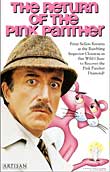 In
the religious fantasy comedy Oh, God! (1977), a store clerk (singer
John Denver) was divinely chosen (through messages on the radio) by old
man George Burns. The film was reprised by two sequels in 1980 and 1984.
Cheech & Chong's first movie, a successful low-budget effort noted
for its pro-cannabis stance and anarchic comedy, was Up in Smoke (1978).
It was followed-up by a number of sequels, including: Cheech and Chong's
Next Movie (1980), Cheech and Chong's Nice Dreams (1981), and
Still Smokin' (1983). In
the religious fantasy comedy Oh, God! (1977), a store clerk (singer
John Denver) was divinely chosen (through messages on the radio) by old
man George Burns. The film was reprised by two sequels in 1980 and 1984.
Cheech & Chong's first movie, a successful low-budget effort noted
for its pro-cannabis stance and anarchic comedy, was Up in Smoke (1978).
It was followed-up by a number of sequels, including: Cheech and Chong's
Next Movie (1980), Cheech and Chong's Nice Dreams (1981), and
Still Smokin' (1983).
Traditional comedies also did well. Blake Edwards revived his original
The Pink Panther (1964) in a series of 70s-80s Inspector Clouseau/Pink
Panther films. Inspector Clouseau (Peter Sellers) reappeared in two sequels:
The Return of the Pink Panther (1975) and Revenge of the Pink
Panther (1978) -
- The Return of the Pink Panther (1975)
- The Pink Panther Strikes Again (1976)
- Revenge of the Pink Panther (1978)
- The Trail of the Pink Panther (1982)
- Curse of the Pink Panther (1983)
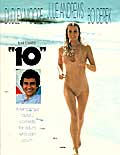 Audiences
also enjoyed Edwards' sexy comedy 10 (1979)
about the mid-life crisis of a successful songwriter named George Webber
(Dudley Moore) who was torn between lady friend Julie Andrews and an unknown
fantasy blonde, corn-row-haired beauty (Bo Derek in her screen debut)
on the beach. The film generated the catch-phrase for the perfect woman
("She's a 10") and popularized Ravel's Bolero due to its infamous
bedroom scene. Love At First Bite (1979) spoofed the Dracula
films, with George Hamilton as the vampirish East European count who moved
to New York (with servant Renfield played by Arte Johnson) and strove
to make Susan Saint James his bride. Audiences
also enjoyed Edwards' sexy comedy 10 (1979)
about the mid-life crisis of a successful songwriter named George Webber
(Dudley Moore) who was torn between lady friend Julie Andrews and an unknown
fantasy blonde, corn-row-haired beauty (Bo Derek in her screen debut)
on the beach. The film generated the catch-phrase for the perfect woman
("She's a 10") and popularized Ravel's Bolero due to its infamous
bedroom scene. Love At First Bite (1979) spoofed the Dracula
films, with George Hamilton as the vampirish East European count who moved
to New York (with servant Renfield played by Arte Johnson) and strove
to make Susan Saint James his bride.
Genre Films Refashioned for the 70s: Westerns
Widening cracks in the American dream after the 60s were
reflected in a number of disturbing, skeptical, pessimistic and provocative
revisionist westerns, that questioned the mythical vision of the Old West.
Traditional western films in the 1970s were being transformed -- classic
frontier heroes of the past were being replaced by more realistic visions
of the frontier, by more violent depictions, by more authentic portrayals
of racism and prejudice against Native Americans, and by "urban"
cowboys who could take the law into their own hands (such as Clint Eastwood's
detective Dirty Harry (1971)). Symbolically,
this was evidenced, in part, by the deaths in this decade of two influential
directors who had placed their personal imprint upon the western genre
during Hollywood's classic past:
John Wayne, the genre's greatest icon, gave his final
feature film performance after almost 50 years in cinema (mostly in westerns)
in over 140 lead roles, with his last lead role as aging/dying
Western gunslinger John Bernard Books in director Don Siegel's The
Shootist (1976). 72 year-old Wayne died shortly thereafter of lung
and stomach cancer in June, 1979. The western also starred Lauren Bacall
as fiesty widow Mrs. Rogers, and future director Ron Howard as the hero-worshipping
son. Wayne had won his sole career Oscar at an Oscars ceremony
in the spring of 1970 for his Best Actor-nominated performance in True
Grit (1969), defeating "urban" cowboys Jon Voight and Dustin
Hoffman for their nominated roles in John Schlesinger's X-rated Midnight Cowboy (1969).
 After
his landmark film Bonnie and Clyde (1967),
director Arthur Penn filmed Thomas Berger's novel Little Big Man (1970),
an episodic, revisionist western tale of the picaresque (and fictional)
adventures of 121-year old frontier drifter Jack Crabb (Dustin Hoffman)
in a series of historical events told in flashback (he was the last survivor
of Custer's Last Stand) - a telling film about hero worship and the abuse
and slaughter of minority groups, with relevant parallels between the
Indian wars and America's military involvement in Vietnam. Ralph Nelson's
anti-racist western Soldier Blue (1972) dramatized the 1864 Sand
Creek Massacre tragedy and brutal mistreatment of Indians. After
his landmark film Bonnie and Clyde (1967),
director Arthur Penn filmed Thomas Berger's novel Little Big Man (1970),
an episodic, revisionist western tale of the picaresque (and fictional)
adventures of 121-year old frontier drifter Jack Crabb (Dustin Hoffman)
in a series of historical events told in flashback (he was the last survivor
of Custer's Last Stand) - a telling film about hero worship and the abuse
and slaughter of minority groups, with relevant parallels between the
Indian wars and America's military involvement in Vietnam. Ralph Nelson's
anti-racist western Soldier Blue (1972) dramatized the 1864 Sand
Creek Massacre tragedy and brutal mistreatment of Indians.
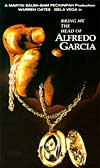 After
his success with the ultra-violent The Wild Bunch
(1969), interpreted as an allegory of the Vietnam War conflict,
Sam Peckinpah directed other unusual westerns in the 70s: After
his success with the ultra-violent The Wild Bunch
(1969), interpreted as an allegory of the Vietnam War conflict,
Sam Peckinpah directed other unusual westerns in the 70s:
- his lyrical and atypically offbeat The Ballad of
Cable Hogue (1970) with Jason Robards and Stella Stevens
- Pat Garrett and Billy the Kid (1973), Peckinpah's
revisionist elegy for the old-style western, ending with a duel between
the legendary western heroes and one-time partners - James Coburn as
Pat Garrett and Kris Kristofferson as Billy the Kid
- the bizarre, grim and nihilistic Bring Me the Head
of Alfredo Garcia (1974) about a bloody, bounty-hunting odyssey
through Mexico for the head of a two-timing Mexican gigolo
Other film-makers that produced revisionistic westerns
during this decade included Robert Altman (McCabe & Mrs.
Miller (1971),
Buffalo Bill and the Indians (1976)), and Clint Eastwood (The
Outlaw Josey Wales (1976)).
Genre Films Refashioned for the 70s: War
Films and Dramas
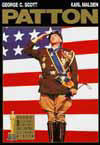 Joseph
Heller's novel served as the basis for Buck Henry's adaptation for
Mike Nichols' absurdist anti-war satire Catch-22 (1970) with
Alan Arkin as bomber pilot Yossarian caught in the insanity of war.
Director Franklin J. Schaffner's superb screen biography of WWII General
George S. Patton in Best Picture-winning Patton
(1970) (also
titled Patton - Lust for Glory) was essentially a war picture
that could be viewed two ways - it was either a larger-than-life
praiseworthy portrayal of the heroic American general by Oscar-winning
George C. Scott (who refused to be present at the Academy Awards
to accept his Best Actor Oscar), or it was a subversive view of
the flawed military figure noted for ivory-handled pistols and verbal/physical
abuse of a battle-fatigued soldier. [Note: Francis Ford Coppola
co-wrote the screenplay for Patton
before his Godfather fame!] Joseph
Heller's novel served as the basis for Buck Henry's adaptation for
Mike Nichols' absurdist anti-war satire Catch-22 (1970) with
Alan Arkin as bomber pilot Yossarian caught in the insanity of war.
Director Franklin J. Schaffner's superb screen biography of WWII General
George S. Patton in Best Picture-winning Patton
(1970) (also
titled Patton - Lust for Glory) was essentially a war picture
that could be viewed two ways - it was either a larger-than-life
praiseworthy portrayal of the heroic American general by Oscar-winning
George C. Scott (who refused to be present at the Academy Awards
to accept his Best Actor Oscar), or it was a subversive view of
the flawed military figure noted for ivory-handled pistols and verbal/physical
abuse of a battle-fatigued soldier. [Note: Francis Ford Coppola
co-wrote the screenplay for Patton
before his Godfather fame!]
Tora! Tora! Tora! (1970) was an excellent documentary
examination of the attack on Pearl Harbor from both the Japanese and American
points of view. Midway (1976) re-created the famous sea battle
of World War II - enhanced with "Sensurround." Ted Post's Go Tell the
Spartans (1978) was one of the earliest US anti-war films to realistically
confront the reality of the Vietnam War - in a story set in Vietnam in
1964 about a doomed platoon and its leader (Burt Lancaster). After
his great successes with both Who's Afraid of Virginia
Woolf? (1966) and The Graduate (1967),
Mike Nichols' surrealistic black comedy Catch-22 (1970), based
on the best-selling novel by Joseph Heller, observed the absurdity and
idiocy of war.
 Scriptwriter
Paddy Chayefsky's provocative black satire on the shallowness of TV
news, Network
(1976), directed by Sidney Lumet, created the decade's
catch-phrase shouted by demented USB anchor Howard Beale
(Peter Finch who won a posthumous Oscar): "I'm as mad
as hell, and I'm not gonna take this anymore!"
Charlie Chaplin's 1957 over-indulgent, anti-American film A
King in New York (1957) was first screened in the United
States in 1973, sixteen years after its European premiere.
Martin Ritt's social-problem drama Norma Rae (1979),
about a widowed mother and cotton mill worker who struggled
for decent working conditions, brought a first Oscar win to
Sally Field (famous for lighter film fare such as TV's The
Flying Nun). Scriptwriter
Paddy Chayefsky's provocative black satire on the shallowness of TV
news, Network
(1976), directed by Sidney Lumet, created the decade's
catch-phrase shouted by demented USB anchor Howard Beale
(Peter Finch who won a posthumous Oscar): "I'm as mad
as hell, and I'm not gonna take this anymore!"
Charlie Chaplin's 1957 over-indulgent, anti-American film A
King in New York (1957) was first screened in the United
States in 1973, sixteen years after its European premiere.
Martin Ritt's social-problem drama Norma Rae (1979),
about a widowed mother and cotton mill worker who struggled
for decent working conditions, brought a first Oscar win to
Sally Field (famous for lighter film fare such as TV's The
Flying Nun).
Coincidentally, James Bridges' topical thriller
film The
China Syndrome (1979) about a narrowly-avoided global
disaster, starred Michael Douglas and Jane Fonda (the
third highest box-office star of the year) as a TV news
team and Jack Lemmon as a nuclear power plant employee.
It opened about two weeks before the potentially-deadly
'melt-down' accident at the nuclear power plant Three
Mile Island (near Harrisburg, Pennsylvania) on March 28,
1979 - and benefited from the unexpected publicity.
Genre Films Refashioned for the 70s: Film
Noirs and Crime Films
 Although
film noir was traditionally a genre limited
to the 1940s and 50s, it re-emerged in the disillusioned,
post-Watergate era with emigre Polish director Roman
Polanski's latter-day brilliant, neo-noir contribution
in homage to the detective melodramas of the past.
His film was the complex and colorful
Chinatown (1974) - about
the uncovering of political and capitalist corruption,
scandal (and incest) surrounding a water conspiracy
set in 1930s Los Angeles. It featured a beautifully-constructed
original screenplay written by the film's sole Oscar-winner
Robert Towne, Jack Nicholson as a meddling private
gumshoe Jake Gittes searching in a tangled plot of
deceptive and perverse double-crosses, and Faye Dunaway
as an alluring and mysterious vamp. Gittes suffered
a painful nose injury (inflicted by knife-wielding
Polanski), and heard co-star Faye Dunaway's famous
wrenching line: "She's
my sister...she's my daughter." In the film's
final line after the surprise death of Jake's love,
he was told: "Forget
it, Jake. It's Chinatown." Although
film noir was traditionally a genre limited
to the 1940s and 50s, it re-emerged in the disillusioned,
post-Watergate era with emigre Polish director Roman
Polanski's latter-day brilliant, neo-noir contribution
in homage to the detective melodramas of the past.
His film was the complex and colorful
Chinatown (1974) - about
the uncovering of political and capitalist corruption,
scandal (and incest) surrounding a water conspiracy
set in 1930s Los Angeles. It featured a beautifully-constructed
original screenplay written by the film's sole Oscar-winner
Robert Towne, Jack Nicholson as a meddling private
gumshoe Jake Gittes searching in a tangled plot of
deceptive and perverse double-crosses, and Faye Dunaway
as an alluring and mysterious vamp. Gittes suffered
a painful nose injury (inflicted by knife-wielding
Polanski), and heard co-star Faye Dunaway's famous
wrenching line: "She's
my sister...she's my daughter." In the film's
final line after the surprise death of Jake's love,
he was told: "Forget
it, Jake. It's Chinatown."
Polanski was arrested for statutory rape in 1977 on charges
of luring a 13-year-old girl (later revealed to be Samantha Geimer) to
the home of actor Jack Nicholson under the pretext of photographing her
for a French fashion magazine, and then drugging her with a Quaalude tranquilizer,
and raping her. In early 1978, Polanski fled the country to France just
hours before he was to have been sentenced in a California court for his
admitted unlawful sexual relations, and has remained a 'fugitive' ever
since.
Arthur Penn's enigmatic thriller Night Moves (1975)
with Gene Hackman and Melanie Griffith (in an early role) also captured
the mood of the post-Watergate era - a time of America's lost innocence.
Writer/director Paul Schrader's Hardcore (1979) was a variation
of John Ford's western The Searchers (1956)
(and Martin Scorsese's Taxi Driver (1976)),
the story of a morally-righteous, Michigan businessman's (George C. Scott)
search for his runaway daughter Kristen (Ilah Davis) involved in pornography
and prostitution in California - with the assistance of a likeable hooker
named Niki (Season Hubley), and most famous for his anguished cry "Turn
it off! TURN IT OFF!" when he sees her in a sordid, low-budget porno
film.
Buddy Films:
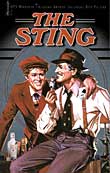 One of the best-loved, award-winning, box-office champs of the 70s was Universal
Pictures' entertaining, plot-twisting, Best Picture-winning film The
Sting (1973), reviving the buddy team of Paul Newman and Robert Redford
(as two small-time Chicago con artists famous for the "Set-Up,"
the "Hook," the "Tale," the "Wire," the
"Shut-Out," and the "Sting" - all inter-titles) and
featuring the piano ragtime of turn-of-the-century black composer Scott
Joplin. The stars were first successfully paired in George Roy Hill's
earlier Butch Cassidy and the Sundance Kid (1969)
(also successfully re-released in 1974). One of the best-loved, award-winning, box-office champs of the 70s was Universal
Pictures' entertaining, plot-twisting, Best Picture-winning film The
Sting (1973), reviving the buddy team of Paul Newman and Robert Redford
(as two small-time Chicago con artists famous for the "Set-Up,"
the "Hook," the "Tale," the "Wire," the
"Shut-Out," and the "Sting" - all inter-titles) and
featuring the piano ragtime of turn-of-the-century black composer Scott
Joplin. The stars were first successfully paired in George Roy Hill's
earlier Butch Cassidy and the Sundance Kid (1969)
(also successfully re-released in 1974).
Other buddy films in the 70s (and later decades) included
some spin-offs:
- Sean Connery and Michael Caine in John Huston's The
Man Who Would Be King (1975)
- George Burns (in his first film in decades) and Walter
Matthau as two old-time vaudevillians who hated each other (Lewis and
Clark) in Herbert Ross' The Sunshine Boys (1975), an adaptation
of Neil Simon's play
- Robert Redford and Dustin Hoffman as Washington
Post reporters uncovering Watergate in All the President's Men
(1976)
- Arthur Hiller's buddy film comedy Silver Streak (1976)
with Gene Wilder as a harmless book editor who witnessed a murder during
a cross-country train trip (and then pretended to be black) and Richard
Pryor as a petty thief; its success led to the equally-successful sequel
Stir Crazy (1980)
Musicals and Dance Films:
Musicals were also big hits - Fiddler on the Roof
(1971) was a successful box-office hit faithful to the long-running
Broadway play, with Chaim Topol as Tevye - a Jewish dairyman in a small
Czarist Russian village (in a role that Zero Mostel made famous). In the
same year, an unconventional remake of an earlier musical, The Wiz
(1971) starred Richard Pryor as the Wizard of Oz, Michael Jackson
as the Scarecrow, and Diana Ross as Dorothy.
 Director
Bob Fosse's great revolutionary musical Cabaret
(1972) and All That Jazz (1979) were quite
a contrast to the sugary musicals of the 60s like Mary Poppins
(1964)
and The Sound of Music (1965). It
was an impressive look at life in pre-War Weimer Germany between
the wars, featuring stylish choreography and Minnelli's show-stopping
performance as Berlin showgirl Sally Bowles. Liza Minnelli and
Joel Grey (as the androgynous Master of Ceremonies) were both
awarded Oscars for their performances, in addition to a statuette
for the director (among its eight wins). As previously mentioned,
Martin Scorsese attempted to capitalize on Liza Minnelli's star-glamour
and classic musicals of the past, and cast her in his failed expressionistic
musical New York, New York (1977). Director
Bob Fosse's great revolutionary musical Cabaret
(1972) and All That Jazz (1979) were quite
a contrast to the sugary musicals of the 60s like Mary Poppins
(1964)
and The Sound of Music (1965). It
was an impressive look at life in pre-War Weimer Germany between
the wars, featuring stylish choreography and Minnelli's show-stopping
performance as Berlin showgirl Sally Bowles. Liza Minnelli and
Joel Grey (as the androgynous Master of Ceremonies) were both
awarded Oscars for their performances, in addition to a statuette
for the director (among its eight wins). As previously mentioned,
Martin Scorsese attempted to capitalize on Liza Minnelli's star-glamour
and classic musicals of the past, and cast her in his failed expressionistic
musical New York, New York (1977).
Fosse's largely semi-autobiographical, Best Picture-nominated
All That Jazz (1979), which won four Oscars (Best
Art Direction, Best Costume Design, Best Film Editing, and Best
Adapted Score) from its nine nominations, was a frenzied
combination of choreography, flashbacks, and surrealism, with
Roy Scheider as Joe Gideon (based on Fosse himself working on
the production of the musical Chicago
in 1975) - a work-obsessed, self-destructive Broadway choreographer
and director. Many of the characters were either based on people
in Fosse's life or characters who essentially played themselves.
It was notable for Gideon's early-morning greeting in front
of a mirror: "It's show
time!", and for his by-pass surgery scene. [Note: Rob Marshall's
version of Fosse's play, Chicago (2002) won the Best
Picture Oscar.]
Bette Midler starred in the lead role (based on rock star
singer Janis Joplin) in The Rose (1979). The successful theatrical
re-release of The Sound of Music (1965)
in 1973 demonstrated its tremendous long-term popularity. The hit Broadway
rock opera from Tim Rice and Andrew Lloyd Webber, Jesus Christ, Superstar (1973) came to the screen in 1973 and
modernized segments of Jesus Christ's (Ted Neeley) life. Coincidentally, it was released to the screen the same year as composer Stephen Schwartz's and director David Greene's Godspell (1973), co-written by John-Michael Tebelak, and derived from the musical play "Godspell: A Musical Based on the Gospel According to St. Matthew," but taking place on the streets of New York. Another rock opera Tommy
(1975), by controversial director Ken Russell, featured the Who. Milos
Forman followed up his remarkable Oscar sweep for One
Flew Over the Cuckoo's Nest (1975) about a rabble-rousing inmate
(Jack Nicholson) in a mental hospital battling an icy and repressive nurse
(Louise Fletcher), with Hair (1979) - an adaptation of the Broadway
hit musical about the hippie generation. One of the most celebrated concert
films was director Martin Scorsese's The Last Waltz (1978) - the
final live performance by The Band, and guest performers Bob Dylan, Van
Morrison, and Joni Mitchell.
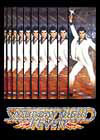 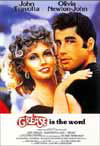 Two
teen-oriented films with rock soundtracks (and both with John Travolta)
were produced by Robert Stigwood, and marked a semi-comeback for the musical
genre: Two
teen-oriented films with rock soundtracks (and both with John Travolta)
were produced by Robert Stigwood, and marked a semi-comeback for the musical
genre:
(1) director John Badham's Saturday Night Fever
(1977) that combined disco fever, the hit music of the Bee Gees,
and a star-making vehicle for John Travolta in his first film role (he
had been a TV star on Welcome Back, Kotter) as Brooklyn-dwelling
Tony Manero - with tight white polyester pants dancing to You Should
Be Dancing and other dance songs; Travolta's dance instructor Deney
Terrio would go on to host a popular TV series titled Dance Fever
(from 1979-85); the film was based on an article by rock journalist
Nik Cohn
(2) Grease (1978), a zesty, nostalgic musical
spoof of the 50s, developed from a long-running Broadway hit, was the
highest grossing film of its year, and again starred Travolta (as Danny
Zuko) and pop singer Olivia Newton-John (as Sandy)
The Buddy Holly Story (1978), another popular music-related
film, starred a convincing Gary Busey as the rock & roll star from
Lubbock, Texas who became famous for the song "Peggy Sue," and
who tragically died in a 1959 plane crash.
Sequels and Re-Makes Fever:
Early foreshadowings of things to come surfaced in the
70s - the popular sequel or re-make. Buena Vista's Herbie Rides Again
(1973) followed The Love Bug (1969). Disney's Benji (1974)
also encouraged the follow-up film For the Love of Benji (1977).
Tom Laughlin's biker film Born Losers (1967) introduced
Billy Jack - a half-Indian fighter that the writer-director-star worked
into a series of action films. The successor was Billy Jack (1971),
again starring Tom Laughlin (who both produced and directed), and The
Trial of Billy Jack (1974), followed by Billy Jack Goes to Washington
(1977) -
the last completed film in the series.
The western adventure film A Man Called Horse (1970), noted
for its gruesome Sun Vow initiation ceremony, starred Richard
Harris as English aristocrat Lord John Morgan who lived among
the Sioux. It led to two sequels: The Return of a Man Called Horse (1976) and Triumphs
of a Man Called Horse (1983).
Barbra Streisand's role as Fanny Brice in Funny Girl
(1968) was brought back in Funny Lady (1975). Hitchcock's 1935
espionage classic, remade with Kenneth More in 1959, was again remade
as The Thirty-Nine Steps (1978) and closely based on the original
John Buchan novel, with Robert Powell replacing Robert Donat as on-the-run
Richard Hannay character. Jack Clayton's period drama The Great Gatsby
(1974), with Robert Redford in the lead role as the self-made millionaire
and Mia Farrow as socialite Daisy, was the third film version of F. Scott
Fitzgerald's classic 1925 novel. [The second version in 1949 starred Alan
Ladd in the title role.]
 The
suspenseful Agatha Christie who-dun-it Murder on the Orient Express
(1974) was set on a luxurious train, with Albert Finney as Hercule
Poirot. It was a sequel to And Then There Were None (1945) and
brought a Best Supporting Actress Oscar and career comeback to
Ingrid Bergman. The effective occult horror film The Omen (1976) with
Gregory Peck as diplomat Robert Thorn and Lee Remick as his wife
- who both adopt Lucifer's son, was sequeled with a trilogy of
films: Damien:
Omen II (1978), and The Final Conflict (1981) (aka
Omen III).
There were further films in the series after the 70s and
early 80s: the TV movie Omen IV: The Awakening (1991),
and the remake The Omen (2006). The
suspenseful Agatha Christie who-dun-it Murder on the Orient Express
(1974) was set on a luxurious train, with Albert Finney as Hercule
Poirot. It was a sequel to And Then There Were None (1945) and
brought a Best Supporting Actress Oscar and career comeback to
Ingrid Bergman. The effective occult horror film The Omen (1976) with
Gregory Peck as diplomat Robert Thorn and Lee Remick as his wife
- who both adopt Lucifer's son, was sequeled with a trilogy of
films: Damien:
Omen II (1978), and The Final Conflict (1981) (aka
Omen III).
There were further films in the series after the 70s and
early 80s: the TV movie Omen IV: The Awakening (1991),
and the remake The Omen (2006).
Major sequels of much earlier classics included the following:
- producer Dino de Laurentiis' $24 million inferior remake
of the 1933 classic, King Kong (1976) with Jessica Lange in the
Fay Wray role and Charles Grodin as the Robert Armstrong character
- Barbra Streisand with Kris Kristofferson (as a fading
star) in a rock version of A Star is Born (1976) - the third
version of the film
- the H.G. Wells mad-scientist classic, The Island
of Dr. Moreau (1976), starred Burt Lancaster as the eponymous scientist
engaged in genetic research; it was earlier filmed as The Island
of Lost Souls (1933) with Charles Laughton, and later remade by
director John Frankenheimer as The Island of Dr. Moreau (1996)
with Marlon Brando
- Heaven Can Wait (1978), a re-make of the comedy/drama
Here Comes Mr. Jordan (1941)
The success of outer space-oriented films, such as Star
Wars (1977), generated the 11th James Bond space-motif adventure
Moonraker (1979) (with Roger Moore). MGM brought back twenty-nine
years of its past glory in That's Entertainment (1974) with documentary-style
screen highlights of its greatest musicals. (A sequel quickly followed
in 1976.)
 Film History of the 1970s
Film History of the 1970s
Part 1, Part 2, Part 3, Part 4, Part 5, Part 6

 
|
